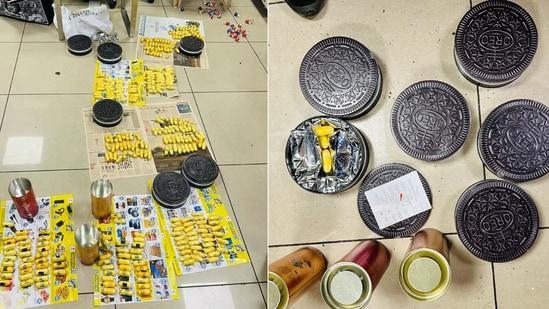Cocaine Smuggling Shocker: Woman Busted at Mumbai Airport With ₹62 Crore Hidden in Oreo Boxes
The Directorate of Revenue Intelligence (DRI) has uncovered yet another startling cocaine smuggling attempt—this time involving an unlikely disguise. A woman traveling from Doha was intercepted at Mumbai International Airport on July 14, carrying over six kilograms of cocaine cleverly concealed inside boxes labeled as Oreo biscuits and chocolates. The street value of the drugs? A staggering ₹62.6 crore.
How It Unfolded: Woman From Doha Intercepted
A seemingly ordinary flight from Doha turned into a high-stakes drug bust after DRI officials received a tip-off that an Indian female passenger would be attempting to smuggle drugs into India. As the woman reached Mumbai, she was stopped immediately by authorities based on intelligence inputs.
During the screening process, DRI officers found nine large boxes in her luggage—six labeled as Oreo biscuits and three labeled as chocolates. What appeared to be snacks turned out to be something much more sinister.
“All nine boxes were found to contain capsules filled with a white powdery substance, which was later confirmed to be cocaine,” said a senior DRI official on condition of anonymity.
The capsules—a total of 300—were tested with field kits on the spot. The results came back positive for cocaine. The weight? A total of 6,261 grams or roughly 6.26 kilograms.
Timeline of Events: From Tip-Off to Arrest
- July 14: DRI receives intelligence regarding a female passenger from Doha.
- The suspect arrives at Mumbai Airport and is immediately intercepted.
- Six boxes of Oreo biscuits and three boxes of chocolates are seized from her luggage.
- Drug detection kits are used on the spot to test the white powder. Results confirm cocaine presence.
- The woman is formally arrested, and over ₹62 crore worth of cocaine is seized.
Not an Isolated Case: A Pattern Emerges
This isn’t the first notable drug trafficking attempt foiled in Mumbai recently. Less than a month earlier, on June 22, another arrest was made under equally alarming circumstances.
A man traveling from Sierra Leone was caught after DRI officials recovered over one kilogram of cocaine concealed internally. Yes, internally—as in, he had swallowed capsules of narcotics before boarding his flight to India. This dangerous and extreme method of concealment led officials to quickly hospitalize the suspect for a medically supervised retrieval of the drugs.
Just two days before that, on June 20, a Nigerian woman was similarly caught while traveling by bus from Delhi to Mumbai. DRI officers followed her for nearly 50 kilometers before stopping and searching her bags. Her luggage revealed substantial amounts of narcotic substances.
Each of these cases, as isolated as they may seem, points to a troubling trend: Mumbai is increasingly becoming a target route for international drug smugglers.
Official Statements and DRI’s Role
The DRI, Mumbai zone, has been intensifying its vigilance in recent months. The agency relies heavily on precise intelligence inputs and has adopted a more targeted, surveillance-based approach to tackling drug trafficking.
“We’re not just looking at traditional smuggling routes anymore. There’s a clear shift in methodologies—from body packing to cleverly disguised packaging in food cartons,” a DRI spokesperson remarked.
In the past, smugglers focused on concealing drugs within shoes, electronic devices, or even inside their own bodies. Now, with methods evolving toward branded packaging like cookies and candy, security agencies are under pressure to adapt quicker than ever.
Community Response: Shock and Concern
As news of this seizure circulated on social media and in local communities, the reaction was a mix of shock, disbelief, and growing concern. Many couldn’t help but express unease over how drug smugglers are choosing seemingly innocent disguise strategies.
“Oreo boxes? Seriously? That’s what’s getting past international airports now?” read one user comment on a Facebook news page. The idea that a universal snack often held in children’s hands was used to hide illicit drugs really shook people up—especially parents.
Others raised alarms about the larger problem. Traffickers aren’t just using unlikely items—they’re also exploiting seemingly normal carriers, putting even unwitting passengers at risk if somehow substituted or coerced unknowingly.
What’s Next? Investigation and Broader Implications
With the woman now under arrest, DRI officials say the case has opened more doors than it closed. Investigators have launched a wide-reaching probe to uncover potential links to greater international smuggling syndicates.
The agency believes that Mumbai may be part of a coordinated drug trafficking route involving Doha as a hub. There is also speculation around whether this woman was working solo or was just a courier—perhaps one carefully chosen to deflect suspicion.
It will take time for the full story to unfold. Interviews, communications data, and material leads are being pursued. But while the case is still young, it reinforces one clear message for ports of entry: Smugglers are getting more creative—and bolder.
What Can Be Done?
As clever as these disguises are, they also raise urgent questions around airport security protocols. Are scanners missing these packages? Are sniffer dogs still effective? Should customs now start treating food packages as high-risk items?
Changes in protocol may soon follow. DRI’s recent arrest record might prompt authorities to update equipment, retrain staff, and collaborate even more deeply with international agencies like INTERPOL and DEA to identify potential hidden routes.
For now, what stands out is that real-time intelligence sharing and swift action made a huge difference. Without the tip-off, this cocaine might’ve vanished undetected into the streets of Mumbai, feeding a black market rooted in violence, addiction, and destruction.
A Final Thought
The timing, the disguise, the packaging—it all raises more questions than answers. There’s something deeply unsettling about narcotics traveling in cookie boxes. Perhaps that’s the point. Maybe it’s the mix of the mundane with the illegal that aims to throw off suspicion just long enough for a deal to go through.
Thankfully, this time, it didn’t.

